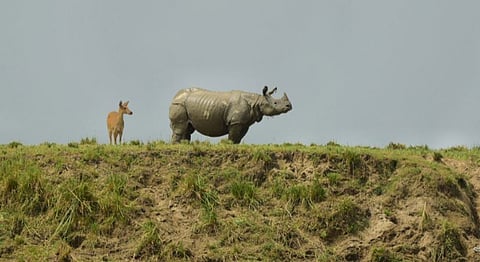
- Home
- Live Blog
- Breaking News
- Top Headlines
- Cities
- NE News
- Sentinel Media
- Sports
- Education
- Jobs

A CORRESPONDENT
NUMALIGARH: The world-famed Kaziranga National Park (KNP) is located in the floodplain ecosystem of the Brahmaputra River that has assisted natural creation of grasslands, wetlands and comparatively less tree forests. Wildlife living in such floodplain ecosystems for hundreds of years have learnt to live in the landscape and have adapted to natural calamities like floods.
Four conservation biologists and wildlife conservationists of the State, Dr Anupam Sarma who is the Coordinator of WWF-India North Bank Landscape, Dr Bibhab Talukdar — secretary general and CEO of Aaranyak, Dr Rathin Barman, Joint Director of Wildlife Trust of India, and Kaushik Barua, CEO of Assam Elephant Foundation, have expressed their opinions as to why haphazard construction of more artificial highlands in KNP may be harmful.
The joint statement by the four conservation biologists and wildlife conservationists was issued after the Union Government asked the State Forest Department to develop more highlands for wild animals to take shelter in the time of floods in the KNP.
A meeting was held between Union Minister for Environment and Forest, Prakash Javadekar and State Environment and Forest Minister Parimal Suklabaidya through video conference on Friday. In the meeting, the Centre also asked the Assam Government to develop a robust system to check movement of heavily loaded vehicles on roads passing through the Park.
The joint statement released by the four conservation biologists and wildlife conservationists stated, “Creating more artificial highlands inside a floodplain ecosystem will fasten the process of ecological succession. In a more simple language, this may be explained as Kaziranga will no longer remain as the habitat of rhino, swamp deer and wild buffalo as the floodplain ecosystem will change to a drier habitat; and in the long run it will not be suitable for rhino, swamp deer and water buffalo. Also, construction of additional artificial highland will drastically change the hydrology of the park. This means the flow of water, especially in the flood period, will change to a great extent. This will hamper the natural cleaning mechanism of the ecosystem. Because of this, the water hyacinth (meteka) will increase in the wetlands of the park and will create ecological problems for the wild animals. Change of hydrology will also change the plant species of the park. There are chances that palatable grasses for the wildlife might be replaced with unpalatable plant species in the long run. Moreover, in every flood, the highlands will erode naturally. The erosion of highland will deposit extra silt in the wetlands and water channels which eventually will dry out. This will add to more damage of Kaziranga’s already fragile ecosystem.”
Assam Government authorities created many highlands in the past for helping the animals in floods and in a move, 33 man-made highlands were erected in 2018. Kaziranga is a flood plain and it has evolved amidst a cycle of floods, erosion and changed course of river over thousands of years. Floods also have been causing major bank erosion in which Kaziranga has lost over 150 sq km in past years. The national park is also facing severe space constraints due to the unabated erosion by the Brahmaputra, which has caused less space and fodder for the animals.
The statement further stated, “Unscientific highlands leads to alter state of the vegetation/habitat composition, as the vegetation are functions of soil moisture regime, soil nutrients, seed bank and other abiotic and biotic factors. Change of vegetation is likely to compel the animals to stray out of the park boundary, especially during the drier seasons. This will bring more threat to the animals, especially to the rhinos. Because of this, human-animal conflict may also rise in the surrounding villages to a great extent. Creation of artificial highlands will also change the visibility for animals inside the park. This might also affect the prey-predator reflex in some areas of the park.”
“In the name of constructing highlands, vehicles will be plying through grasslands and these vehicles are likely to carry invasive plant species or its seeds along with them. This may result in areas inside the park being invaded by such invasive plant species. Further, more highlands will create opening of grassland areas, thus exposing such areas to invasive plant species. Such highlands may act as invasive plant species hotspot because the highlands are immune to flooding effect. Thus in later part, these acts as seed banks and disperses stations of invasive plant species. The herbivores of KNP are competing for sprouting grasses as areas having sprouting grassland have been extensively grazed. These proposed highlands may further reduce grassland area for rhino and other herbivores to graze on. It has been witnessed that natural flood is the only external factor that has an overwhelming power to regulate this ecosystem by controlling populations. More highlands in Kaziranga means we are even allowing unfit wild animals to survive in natural flood and thereby disturbing the natural selection process which is popularly known as ‘survival of the fittest’,” the statement added.
The four conservation biologists and wildlife conservationists also expressed their views on what the government agencies need to focus for the well-being of Kaziranga’s ecosystem. They said, “The plains of Kaziranga along with the natural highlands of Karbi Anglong is a single entity and the importance of Karbi hills should be appreciated and free movement of animals should be allowed rather than constructing artificial highlands. It will be more beneficial if emphasis is given to grassland management, restoration of wetlands and anti-erosion measures rather than making highlands. Undisturbed animal movement in the identified animal corridors of Kaziranga and the adjoining Karbi Hills must be facilitated aggressively by the authorities. Government should expedite the process of construction of the elevated highway project in all the identified locations.”